- global warming
- Roger Coppock
- average warming
- all their instruments are in agreement
- Earth's near surface
- Stevenson Screens
- NASA's gathering of history
- NASA Goddard Institute For Space Studies
- GISTEMP
- United States Historical Climatology Network
- Nobel Prize winning Chemist
- Svante Arrhenius
- Influence of Carbonic Acid
- CO2 greenhouse theory
- CO2 for infrared energy
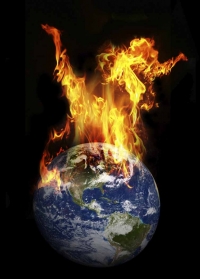
By Roger Coppock
October 7, 2014 (San Diego’s East County) Everybody has heard of global warming. There is at least one article in the news every day. Scientists who study and write about global warming have reasons to say our Earth's near surface is on average warming. All their instruments are in agreement. During most of the last couple of hundred years things have gotten hotter.
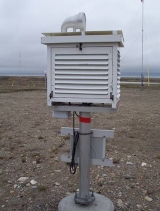 Around the Earth are ground stations, white wooden boxes called "Stevenson Screens" with a thermometer and other instruments inside. More than four out of five of the records 30 years or longer from these instruments show increasing temperatures. According to NASA's gathering of history, the average temperature rise is about 1.2 degrees F per century since 1880. (NASA Goddard Institute For Space Studies, GISTEMP, GLB.Ts+dSST.txt file, J-D AnnMean series)
Around the Earth are ground stations, white wooden boxes called "Stevenson Screens" with a thermometer and other instruments inside. More than four out of five of the records 30 years or longer from these instruments show increasing temperatures. According to NASA's gathering of history, the average temperature rise is about 1.2 degrees F per century since 1880. (NASA Goddard Institute For Space Studies, GISTEMP, GLB.Ts+dSST.txt file, J-D AnnMean series)
Now let's look at what two local weather station records have to say. (Data from the United States Historical Climatology Network database for 2013 as supplied by the Carbon Dioxide Information Analysis Center (CDIAC) at Oak Ridge National Laboratory. Graphs by the author using the R Statistical Package.)
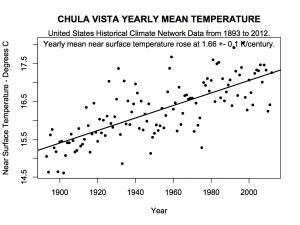 Chula Vista temperatures are rising at 3 degrees F every century. Lake Cuyamaca temperatures are jumping up nearly 5 degrees F per century. This is 2.5 and 4 times the global average, respectively!
Chula Vista temperatures are rising at 3 degrees F every century. Lake Cuyamaca temperatures are jumping up nearly 5 degrees F per century. This is 2.5 and 4 times the global average, respectively!
Now, . . . why? 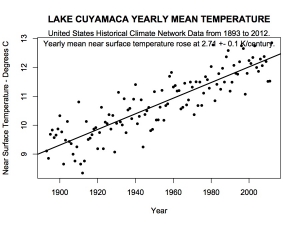
The major reason for this warming, both global and local, has been known since the late 19th Century. Mankind's addition of Carbon Dioxide to the atmosphere from
the burning of coal, oil and natural gas makes our atmosphere increasingly opaque to infrared energy leaving the surface of Earth. The Sun heats the surface of the Earth. The Earth's surface spreads that energy as infrared radiation in all directions. Some of that infrared energy leaves the Earth for outer space, cooling the planet. The rest is trapped by greenhouse gases. The trapped infrared en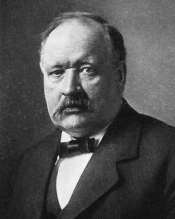 ergy heats the atmosphere.
ergy heats the atmosphere.
The great mathematician Fourier presented an outline of the idea in 1824. However, the first quantitative theory was written by the Nobel Prize winning Chemist, Svante Arrhenius in 1896. (Arrhenius, Svante, 1896. On the Influence of Carbonic Acid in the Air upon the Temperature of the Ground. Philosophical Magazine ser. 5, vol. 41, 237–276. https://nsdl.org/sites/
This 1896 paper makes several predictions about the times and locations of the warming. All of these predictions can now be seen in historical data from ground stations, and other weather instruments. That is a 100% score! Arrhenius was right about nearly everything. Because he did not foresee the explosive rise in fossil fuel use, Arrhenius just underestimated the time the warming would take. (The author gives public talks about global warming theory which cover the Arrhenius' theory in detail.)
One of the predictions made by the modern CO2 greenhouse theory is that dry places warm faster than places with high humidity. There are two reasons for this. First, water vapor is a greenhouse gas that competes with CO2 for infrared energy. ( http://www.newscientist.com/
Roger Coppock, a former computer scientist who was forced into retirement by both cancer and 'death' on an operating table, became a serious amateur climate scientist while helping his son with a science fair project about global warming. Today, a decade later, he is preparing to 'decode' data from NASA's new Orbiting Carbon Observatory satellite.
The East County Magazine is nonprofit news in the public interest, supported by our readers. You can help support our nonprofit award-winning media by donating or becoming a sustaining community member. To donate or get more information visit http://www.eastcountymagazine.org/donate .










Comments
XLNT Article!
San Diego area weather data
URL?
Hot Spot
Man
Campo weather station?